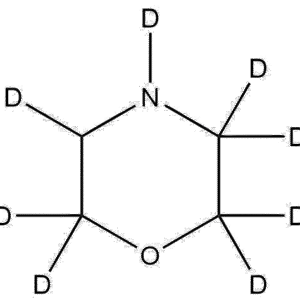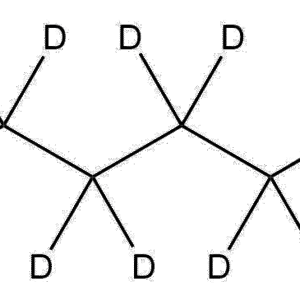OVERVIEW of Heptanoic-d13-acid | CAS 130348-93-5
Heptanoic-d₁₃-acid, also known as enanthic-d₁₃ acid, is a fully deuterated medium-chain fatty acid with the chemical formula C₇D₁₃O₂ and a molecular weight of 145.26 g/mol. This compound features thirteen deuterium atoms that replace all hydrogen atoms in the hydrocarbon chain of native heptanoic acid. The extensive isotopic substitution makes it an exceptional stable isotope-labeled standard for analytical and biochemical studies.
As a deuterated analog of heptanoic acid, it exhibits nearly identical chemical and physical properties, enabling precise comparison and quantification in gas chromatography–mass spectrometry (GC-MS) and liquid chromatography–mass spectrometry (LC-MS) analyses. Its chemical stability, isotopic enrichment, and low reactivity make Heptanoic-d₁₃-acid a valuable tool in lipidomics, metabolomics, and metabolic tracing applications.
This compound is particularly suited for the investigation of medium-chain fatty acid metabolism, energy turnover, and biochemical pathway elucidation in biological, environmental, and food matrices.
CHEMICAL INFORMATION
-
Name: Heptanoic-d₁₃-acid
-
CAS Number: 130348-93-5
-
Molecular Formula: C₇D₁₃O₂
-
Molecular Weight: 143.27 g/mol
-
Isotopic Enrichment: ≥98 atom % D
-
Chemical Class: Deuterated medium-chain fatty acid
-
Solubility: Insoluble in water; soluble in ethanol, diethyl ether, and other organic solvents
APPLICATIONS of Heptanoic-d13-acid | CAS 130348-93-5
1. Analytical Standard for GC-MS and LC-MS:
Heptanoic-d₁₃-acid is widely employed as an internal standard for the quantification of heptanoic acid and other medium-chain fatty acids. Its mass shift relative to non-deuterated heptanoic acid enables highly accurate isotope dilution assays, reducing analytical variability and enhancing reproducibility in quantitative mass spectrometry.
2. Lipidomics and Metabolomics:
In lipidomic studies, Heptanoic-d₁₃-acid serves as a reference molecule to investigate lipid turnover, fatty acid oxidation, and chain elongation pathways. It helps track metabolic conversion processes in cell cultures, tissues, or biofluids, offering insight into energy metabolism, lipid synthesis, and oxidative pathways.
3. Metabolic Tracing and Isotopic Labeling Studies:
Due to its stable deuterium labeling, this compound is highly suitable for non-radioactive metabolic tracing. Researchers utilize it to follow the incorporation and degradation of fatty acids in metabolic flux experiments, providing critical data for understanding cellular energy balance, mitochondrial β-oxidation, and metabolic regulation.
4. Environmental and Food Analysis:
Heptanoic-d₁₃-acid acts as a quality control and calibration standard for detecting and quantifying fatty acids in environmental and food matrices. It aids in validating analytical methods, ensuring accuracy in the measurement of lipid components or contamination by medium-chain fatty acids.
5. Pharmaceutical and Biochemical Research:
This compound supports the study of lipid-based drug formulations and biochemical mechanisms involving fatty acid transport, storage, and breakdown. Its isotopic label allows for precise tracing of biochemical transformations under controlled experimental conditions.
6. Method Development and Quality Assurance:
Analytical laboratories employ Heptanoic-d₁₃-acid for method validation, ensuring that chromatographic and mass spectrometric systems are properly calibrated. Its consistency and high isotopic enrichment enhance data reliability in both qualitative and quantitative workflows.
ADVANTAGES of Heptanoic-d13-acid | CAS 130348-93-5
-
High Isotopic Purity: ≥98 atom % D ensures strong mass differentiation for isotope dilution analysis.
-
Accurate Quantification: Provides reliable internal standardization in GC-MS and LC-MS methods.
-
Stable and Safe: Non-radioactive, chemically stable, and easy to handle.
-
Chemically Equivalent to Native Acid: Exhibits identical physical and chromatographic properties to heptanoic acid.
-
Enhanced Analytical Precision: Reduces matrix interference and improves reproducibility in fatty acid profiling.
-
Broad Applicability: Suitable for biochemical, environmental, and pharmaceutical studies.
-
Long Shelf Life: Resistant to degradation under recommended storage conditions.
SUMMARY
Heptanoic-d₁₃-acid (CAS 130348-93-5) is a deuterium-labeled analog of heptanoic acid designed for advanced analytical, biochemical, and environmental research applications. As a medium-chain fatty acid isotopic standard, it is an indispensable tool for precise quantification, metabolic tracing, and lipid analysis.
Its chemical and physical behavior mirrors native heptanoic acid, allowing it to serve as an ideal internal standard or metabolic tracer in diverse applications. Whether in lipidomics, metabolomics, pharmaceutical formulation, or environmental analysis, Heptanoic-d₁₃-acid delivers high reproducibility, accuracy, and reliability.
At ResolveMass Laboratories Inc., this compound is produced under rigorous quality and isotopic control to ensure exceptional purity and performance. Its stability and precision make it a critical standard for researchers seeking accurate, reproducible results in fatty acid profiling and metabolic studies.
Learn more about,
Deuterated Polymers: A Cornerstone Guide to Synthesis, Applications, and Future Trends
Availability of All the Deuterated Chemicals at ResolveMass Laboratories Inc.
ResolveMass Laboratories: Leading Deuterated Chemical Synthesis Company in the United States.
Deuterated Internal Standards for LC-MS: Selection & Custom Synthesis
How to Choose the Right Deuterated Labelled Chemical Synthesis Company in Canada
How to Choose the Right Deuterium Labelled Compounds Supplier for Your Lab
Deuterium-Labelled Compounds — Synthesis, Applications & Ordering
Custom Synthesis of Deuterated Chemicals





Reviews
There are no reviews yet.